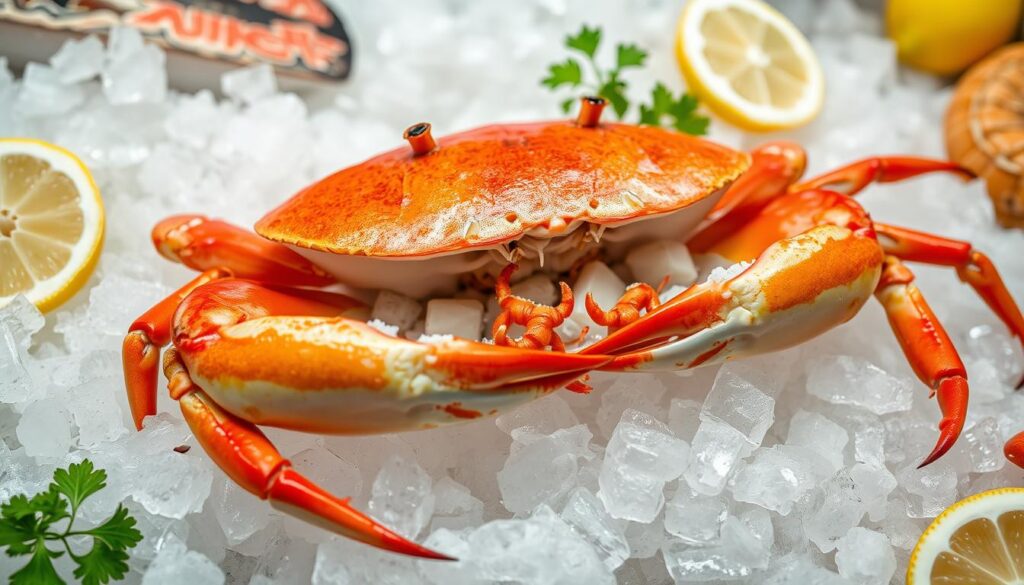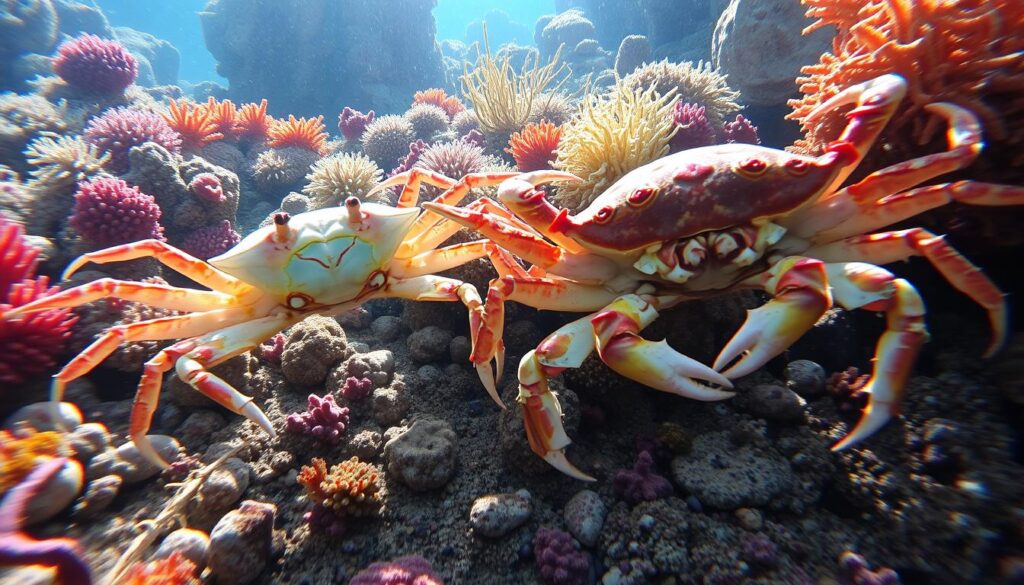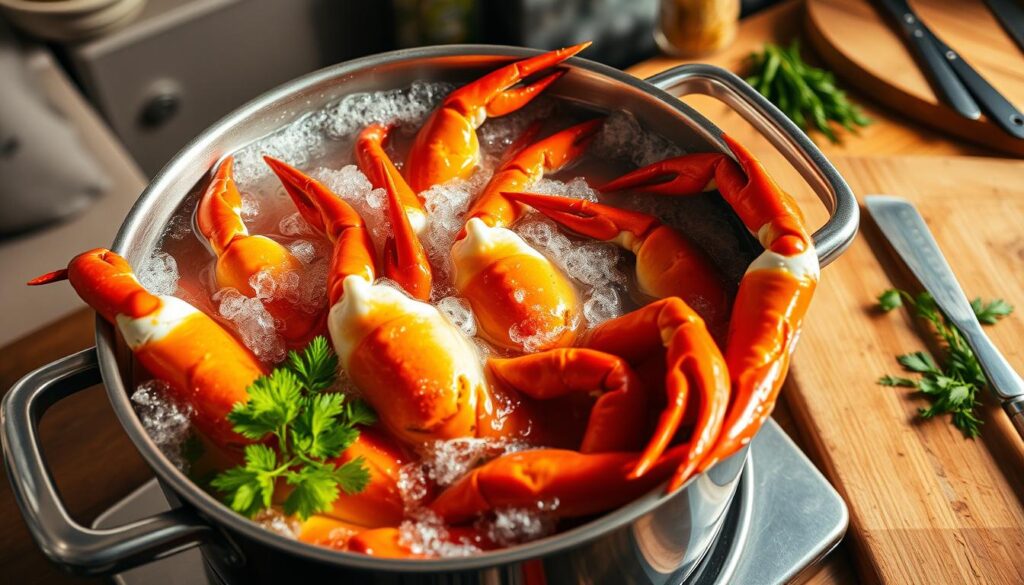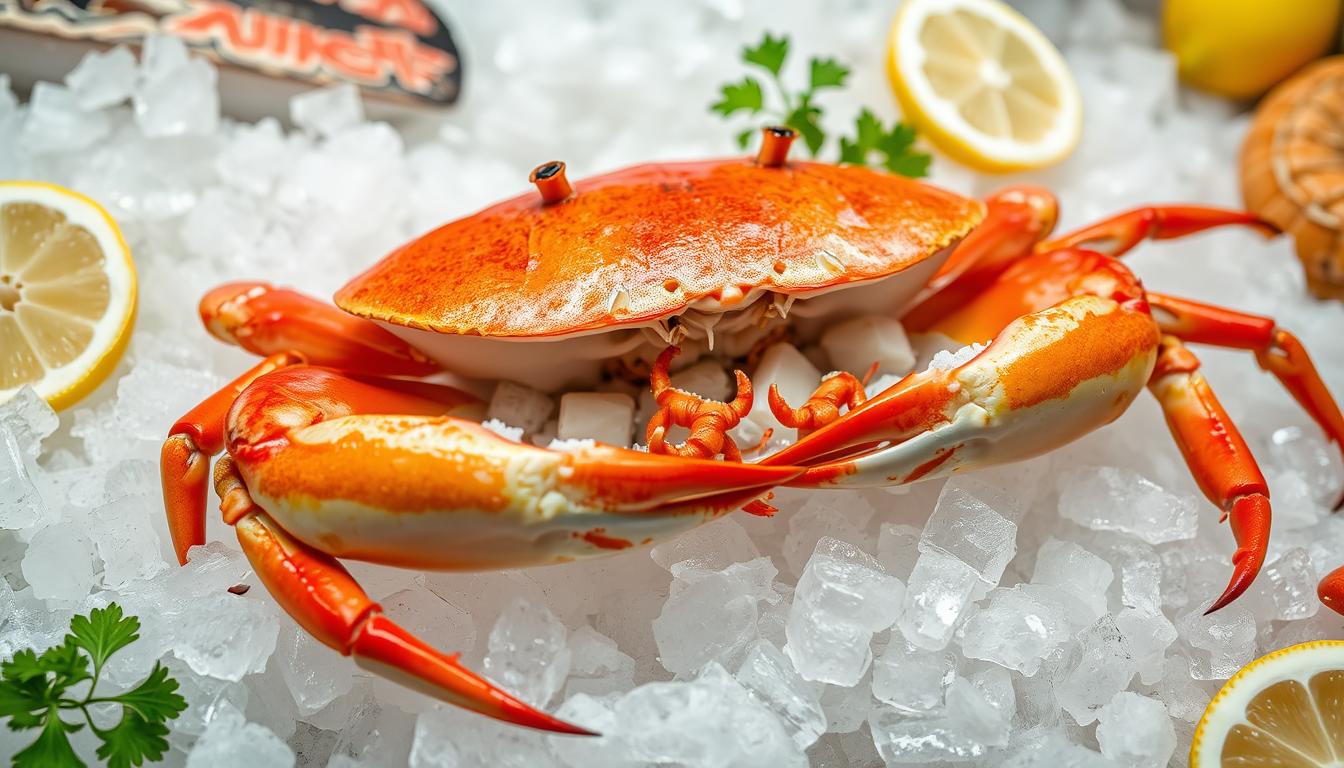Did you know that over 2 billion pounds of snow crab are harvested globally each year? This delectable crustacean, with its succulent white meat and delicate flavor, has become a beloved delicacy across the world. But is snow crab truly considered “real” crab meat, or is it something else entirely? In this comprehensive guide, we’ll dive deep into the mysteries of snow crab, exploring its origins, physical characteristics, and culinary status.
What Is Snow Crab?
Origins and Habitat
Snow crab, scientifically known as Chionoecetes opilio, is a species of crab found primarily in the cold, northern waters of the Pacific and Atlantic Oceans. These crabs thrive in the icy, deep-sea environments off the coasts of Alaska, Canada, and Russia, where they can grow to impressive sizes over their lifespan of 5-7 years.
Physical Characteristics
Snow crabs are easily recognizable by their distinctive white or pale-yellow shells and long, slender legs. Unlike their round-bodied counterparts, such as the Dungeness or blue crab, snow crabs have a more elongated, triangular shape that allows them to navigate the rugged seafloor terrain of their habitat.
Is Snow Crab Real Crab Meat?
The short answer is yes – snow crab is considered a genuine species of crab and its meat is indeed real crab meat. While it may differ in taste and texture from other popular crab varieties, such as king crab or blue crab, snow crab is still a member of the Brachyura family, which encompasses all true crabs.

Key Takeaways
- Snow crab is a real species of crab, belonging to the Brachyura family of true crabs.
- Snow crab is known for its succulent white meat and delicate flavor, making it a popular seafood delicacy.
- Snow crab is harvested primarily in the cold, northern waters of the Pacific and Atlantic Oceans.
- Snow crab can be distinguished from other crab species by its elongated, triangular shape and long, slender legs.
- While the taste and texture of snow crab may differ from other crab varieties, it is still considered a genuine crab meat.
What Is Snow Crab?
Snow crab, also known as the Chionoecetes opilio, is a unique species of crustacean found in the cold waters of the northern Pacific and Atlantic Oceans. These captivating creatures are renowned for their distinctive white or pale coloration, which has earned them the popular moniker “snow crab.” Their natural habitat lies primarily on the ocean floor, at depths ranging from 30 to 600 meters, where they thrive in the chilly and nutrient-rich environments.
Origins and Habitat
The snow crab species is native to the northern regions of the Pacific and Atlantic Oceans, with their natural range spanning from Alaska to the northwest coast of Canada, as well as the waters off the coasts of Greenland and Siberia. These hardy crustaceans have adapted to the harsh, cold-water conditions, making their homes on the seafloor in depths that can reach up to 600 meters.
Physical Characteristics
- The snow crab is known for its distinctive long, spindly legs and large, powerful claws, which it uses for both defense and hunting.
- The average size of a snow crab can range from 10 to 15 centimeters in carapace width, with the larger males typically possessing the most impressive claw size.
- These crabs have a hard, calcified exoskeleton that protects their delicate body, and their coloration can vary from white to pale blue or gray, depending on their environment and age.
The unique physical attributes of the snow crab, combined with its resilience and adaptability to the harsh marine environment, make it a fascinating and sought-after species for both commercial and recreational purposes.
Is Snow Crab Real Crab Meat?
While snow crab is indeed a type of crab, there is some debate around whether it can be considered “real” crab meat on par with other popular varieties like Dungeness, blue, or king crab. Snow crab belongs to the Chionoecetes genus, which is distinct from the true crabs of the Brachyura infraorder. However, most seafood experts and consumers still regard snow crab as a legitimate crab species and a viable alternative to other crab meats.
The classification of snow crab as a true crab is a subject of ongoing discussion among scientists. While it shares certain physical characteristics with other crab species, its unique attributes have led some to question whether it should be considered a true crab. Nonetheless, the culinary world widely accepts snow crab as a distinct and valuable crab meat type.
“Snow crab is a unique and delicious crustacean that deserves recognition as a legitimate member of the crab family, even if it doesn’t fit the technical definition perfectly.”
Ultimately, the debate over the taxonomic classification of snow crab is a matter of scientific classification, while its status as a prized and sought-after crab meat remains firmly established in the culinary world.
Snow Crab vs. Other Crab Species
When it comes to crab varieties, snow crab stands out for its delicate, sweet flavor and slightly firmer texture. Compared to the rich, buttery taste of king crab, snow crab meat has a more delicate profile. It also lacks the robust, briny essence of Dungeness crab, making it a unique and versatile option for seafood enthusiasts.
Taste and Texture Differences
One of the standout features of snow crab is its slightly firmer texture compared to other crab varieties. While it may not be as delicate as the tender, flaky meat of snow crab, its firmer bite can be a desirable quality in certain dishes. The snow crab meat taste is also more subtle and sweet, rather than the pronounced, ocean-fresh flavor of Dungeness crab.
Despite these differences, snow crab is still highly prized for its succulent, snow crab meat texture and can be used in many of the same recipes as other crab types. Its versatility makes it a popular choice for a wide range of crab-based dishes, from crab cakes to seafood salads.

“Snow crab is a unique and delicious option that offers a delicate balance of flavor and texture compared to other crab species.”
Nutritional Value of Snow Crab
Snow crab is a highly nutritious seafood option that offers an array of essential vitamins, minerals, and macronutrients. Whether you’re a health-conscious consumer or simply enjoying the delectable taste of snow crab, understanding its impressive nutritional profile can help you make informed choices about your dietary preferences.
A 3.5-ounce serving of snow crab meat contains approximately 82 calories, 15 grams of protein, and significant amounts of essential nutrients such as selenium, vitamin B12, magnesium, and zinc. This low-calorie, high-protein combination makes snow crab an excellent choice for those seeking a balanced and satisfying meal.
In addition to its protein content, snow crab is also a good source of omega-3 fatty acids, which are known for their potential cardiovascular and cognitive health benefits. These healthy fats can help reduce inflammation and support overall well-being.
To further highlight the nutritional value of snow crab, consider the following breakdown:
- High in protein, providing essential amino acids for muscle growth and repair
- Rich in selenium, an important antioxidant that supports immune function and thyroid health
- Abundant in vitamin B12, which is crucial for energy production and red blood cell formation
- Contains magnesium and zinc, minerals that play vital roles in bone health, metabolism, and immune function
Whether you enjoy snow crab as a main course, in a seafood salad, or as part of a delectable crab cake, its impressive nutritional profile makes it a wonderful choice for those seeking a healthy and delicious seafood option.
Harvesting and Processing Snow Crab
The snow crab industry is a vital part of the global seafood market, with fishermen employing sustainable practices to harvest this coveted crustacean. Snow crabs are primarily caught using specialized crab pots or traps that are lowered to the ocean floor, where the crabs congregate.
Sustainable Fishing Practices
Fishermen in snow crab fisheries must adhere to strict regulations to ensure the long-term sustainability of the resource. These include catch size limits, seasonal restrictions, and quotas that prevent overfishing. Additionally, efforts are underway to make the snow crab harvesting process even more environmentally responsible, such as the use of bycatch reduction devices and the implementation of electronic monitoring systems.
Once the snow crabs are caught, they are cooked and processed onboard the fishing vessels before being distributed to wholesalers and retailers around the world. This meticulous snow crab processing helps to preserve the unique flavor and texture of the meat, ensuring that consumers can enjoy the full culinary experience of this beloved seafood.
| Key Snow Crab Fisheries Facts | Details |
|---|---|
| Harvesting Method | Crab pots or traps lowered to the ocean floor |
| Regulatory Measures | Catch size limits, seasonal restrictions, quotas |
| Sustainability Initiatives | Bycatch reduction devices, electronic monitoring |
| Processing | Cooked and processed on fishing vessels |
The snow crab harvesting and processing industries work in harmony to deliver this delectable seafood to tables around the world, all while prioritizing the long-term sustainability of the snow crab fisheries.
Preparing and Cooking Snow Crab
Cooking snow crab at home is a simple and cost-effective way to enjoy this delectable seafood. The versatility of snow crab allows it to be prepared in a variety of ways, from classic steaming or boiling to more creative recipes.
One of the most popular methods is to steam or boil the whole crab legs. This straightforward approach allows the natural sweetness and tender texture of the snow crab to shine. After cooking, the legs are typically served with melted butter or a flavorful dipping sauce for an indulgent seafood experience.
Beyond the basic steaming or boiling, snow crab meat can be incorporated into a variety of dishes. From salads and pasta to soups and seafood cakes, the versatile flavor and firm texture of snow crab make it a welcome addition to many recipes. The key is to avoid overcooking, as this can lead to a tough, chewy texture.
| Cooking Method | Time | Tips |
|---|---|---|
| Steaming | 5-10 minutes | Place crab legs in a steamer basket and steam until heated through. |
| Boiling | 8-12 minutes | Bring a large pot of water to a boil, then add the crab legs and cook until heated through. |
| Baking | 15-20 minutes | Preheat oven to 350°F. Arrange crab legs on a baking sheet and bake until warm. |
No matter the cooking method, the key to perfectly prepared snow crab is to avoid overcooking. The meat should be tender and sweet, with a delicate flavor that can be enhanced by simple seasonings like salt, pepper, and lemon.

“Snow crab is a versatile and delicious ingredient that can elevate any meal. With a few simple techniques, you can enjoy the sweet, tender meat at home.”
Popular Snow Crab Dishes
From classic preparations to regional specialties, snow crab takes center stage in a diverse array of seafood dishes around the world. The sweet, delicate flavor and tender texture of this crustacean make it a versatile ingredient that shines in a variety of culinary creations.
Snow Crab Legs and Butter
One of the most beloved and straightforward ways to enjoy snow crab is with a simple pairing of steamed or boiled crab legs and a side of drawn butter for dipping. This timeless dish allows the natural sweetness of the snow crab to take the spotlight.
Snow Crab Cocktail
For a refreshing starter, snow crab meat is often incorporated into classic cocktail dishes, where its cool, crisp texture complements the tangy flavors of the cocktail sauce.
Snow Crab Cakes
Snow crab lends itself beautifully to delectable crab cakes, which can be served as an appetizer or a main course. The crab meat is gently combined with breadcrumbs, eggs, and seasonings, then pan-fried or baked until golden brown.
Pacific Northwest Specialties
In the coastal regions of the Pacific Northwest, snow crab is frequently featured in hearty chowders, stews, and bisques, where its sweet flavor and tender texture enhance the overall richness of the dish.
Asian-Inspired Preparations
In parts of Asia, snow crab is sometimes steamed whole and served with a variety of dipping sauces, allowing diners to savor the crab’s natural flavors. This simple yet flavorful approach highlights the versatility of snow crab across regional cuisines.
Whether you’re craving a classic snow crab leg feast or a more creative preparation, this versatile crustacean offers a wealth of delicious possibilities for seafood enthusiasts.
Where to Buy Fresh Snow Crab
As a popular delicacy, fresh snow crab is sought after by seafood enthusiasts across the country. Fortunately, this coveted crustacean is available from a variety of reputable sources, ensuring that where to buy snow crab is not a challenge for most consumers.
The peak snow crab season typically runs from October through March, when the crabs are most plentiful. During this time, snow crab retailers such as seafood markets, grocery stores, and even online vendors offer a range of snow crab products, from whole legs to lump or claw meat.
When purchasing fresh snow crab, it’s important to source it from trusted suppliers to ensure quality and freshness. Many reputable seafood companies now offer convenient snow crab online ordering, allowing consumers to enjoy this delectable treat from the comfort of their own homes.
Whether you’re looking to indulge in a gourmet snow crab feast or incorporate the meat into your favorite recipes, the availability of where to buy snow crab makes it easier than ever to savor this unique and flavorful seafood delicacy.
“Snow crab is a true delicacy that can elevate any seafood dish. Its sweet, delicate flavor and tender texture make it a must-try for any crab enthusiast.”
Conclusion
In summary, snow crab is a genuine crab species that is prized for its sweet, delicate meat. While it may not be considered a “true” crab from a scientific perspective, snow crab is widely recognized and enjoyed as a delectable seafood option. With its unique characteristics, versatile culinary applications, and sustainable fishing practices, snow crab deserves a prominent place alongside other popular crab varieties.
The overview provided in this article has explored the origins, physical traits, and nutritional value of snow crab, as well as the differences between snow crab and other crab species. We’ve also discussed the harvesting and processing methods, preparation techniques, and the diverse range of snow crab dishes that can be found around the world.
Whether you’re a seasoned seafood enthusiast or new to the joys of snow crab, this comprehensive guide has offered insights into why this crab is a truly exceptional and worthy addition to any seafood lover’s repertoire. From its distinct flavor and texture to its sustainable harvesting practices, snow crab proves itself to be a remarkable and versatile culinary delight.
FAQ
Is snow crab real crab meat?
While snow crab is indeed a type of crab, there is some debate around whether it can be considered “real” crab meat on par with other popular varieties like Dungeness, blue, or king crab. Snow crab is classified as belonging to the Chionoecetes genus, which is distinct from the true crabs of the Brachyura infraorder. However, most seafood experts and consumers still regard snow crab as a legitimate crab species and a viable alternative to other crab meats.
What is snow crab?
Snow crab, also known as the Opilio crab, is a type of crustacean that is found in the cold waters of the northern Pacific and Atlantic Oceans. It gets its name from its white or pale coloration. Snow crabs primarily live on the ocean floor at depths ranging from 30 to 600 meters. They have a distinctive appearance with long, spindly legs and large claws that they use for defense and hunting.
How does snow crab compare to other crab species?
Compared to other popular crab varieties, snow crab has a more delicate, sweet flavor and a slightly firmer texture. Its meat is not as rich or buttery as king crab, and it lacks the robust, briny taste of Dungeness crab. However, snow crab is still highly prized for its tender, succulent meat and can be used in many of the same dishes as other crab types.
What is the nutritional value of snow crab?
Snow crab is a highly nutritious food that is low in calories but high in protein, vitamins, and minerals. A 3.5 ounce serving of snow crab meat contains around 82 calories, 15 grams of protein, and significant amounts of selenium, vitamin B12, magnesium, and zinc. It is also a good source of omega-3 fatty acids, making it a healthy choice for seafood lovers.
How is snow crab harvested and processed?
Snow crabs are primarily harvested using crab pots or traps that are lowered to the ocean floor. Fishermen must adhere to strict regulations around catch size, season, and quotas to ensure the sustainability of snow crab populations. After being caught, the crabs are cooked and processed onboard fishing vessels before being distributed to wholesalers and retailers. Efforts are underway to make snow crab fishing even more environmentally responsible.
How is snow crab prepared and cooked?
Snow crab is a versatile ingredient that can be prepared in a variety of ways. The most common method is to simply steam or boil the whole crab legs and serve them with melted butter for dipping. Snow crab meat can also be incorporated into salads, pasta dishes, soups, and seafood cakes. It’s important not to overcook snow crab, as this can make the meat tough and chewy.
What are some popular snow crab dishes?
Snow crab is featured in a wide range of seafood dishes around the world. Classic preparations include snow crab legs with drawn butter, snow crab cocktail, and snow crab cakes. In the Pacific Northwest, snow crab is often incorporated into chowders, stews, and bisques. Meanwhile, in parts of Asia, snow crab may be steamed whole and served with dipping sauces.
Where can I buy fresh snow crab?
Fresh snow crab is available seasonally from seafood markets, grocery stores, and online retailers. The peak snow crab season typically runs from October through March, when the crabs are most plentiful. Consumers can buy whole snow crab legs, lump or claw meat, or even frozen snow crab products. It’s important to source snow crab from reputable suppliers to ensure freshness and quality.

